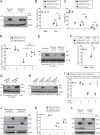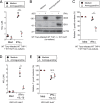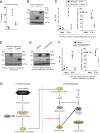Inducible Nitric Oxide Synthase Is a Key Host Factor for Toxoplasma GRA15-Dependent Disruption of the Gamma Interferon-Induced Antiparasitic Human Response
- PMID: 30301855
- PMCID: PMC6178625
- DOI: 10.1128/mBio.01738-18
Inducible Nitric Oxide Synthase Is a Key Host Factor for Toxoplasma GRA15-Dependent Disruption of the Gamma Interferon-Induced Antiparasitic Human Response
Abstract
Although Toxoplasma virulence mechanisms targeting gamma interferon (IFN-γ)-induced cell-autonomous antiparasitic immunity have been extensively characterized in mice, the virulence mechanisms in humans remain uncertain, partly because cell-autonomous immune responses against Toxoplasma differ markedly between mice and humans. Despite the identification of inducible nitric oxide synthase (iNOS) as an anti-Toxoplasma host factor in mice, here we show that iNOS in humans is a pro-Toxoplasma host factor that promotes the growth of the parasite. The GRA15 Toxoplasma effector-dependent disarmament of IFN-γ-induced parasite growth inhibition was evident when parasite-infected monocytes were cocultured with hepatocytes. Interleukin-1β (IL-1β), produced from monocytes in a manner dependent on GRA15 and the host's NLRP3 inflammasome, combined with IFN-γ to strongly stimulate iNOS expression in hepatocytes; this dramatically reduced the levels of indole 2,3-dioxygenase 1 (IDO1), a critically important IFN-γ-inducible anti-Toxoplasma protein in humans, thus allowing parasite growth. Taking the data together, Toxoplasma utilizes human iNOS to antagonize IFN-γ-induced IDO1-mediated cell-autonomous immunity via its GRA15 virulence factor.IMPORTANCEToxoplasma, an important intracellular parasite of humans and animals, causes life-threatening toxoplasmosis in immunocompromised individuals. Gamma interferon (IFN-γ) is produced in the host to inhibit the proliferation of this parasite and eventually cause its death. Unlike mouse disease models, which involve well-characterized virulence strategies that are used by Toxoplasma to suppress IFN-γ-dependent immunity, the strategies used by Toxoplasma in humans remain unclear. Here, we show that GRA15, a Toxoplasma effector protein, suppresses the IFN-γ-induced indole-2,3-dioxygenase 1-dependent antiparasite immune response in human cells. Because NLRP3-dependent production of IL-1β and nitric oxide (NO) in Toxoplasma-infected human cells is involved in the GRA15-dependent virulence mechanism, blocking NO or IL-1β production in the host could represent a novel therapeutic approach for treating human toxoplasmosis.
Keywords: Toxoplasma gondii; cell-autonomous immunity; host-parasite interaction; human immunology; immune suppression; interferon.
Copyright © 2018 Bando et al.
Figures







Similar articles
-
Toxoplasma Effector GRA15-Dependent Suppression of IFN-γ-Induced Antiparasitic Response in Human Neurons.Front Cell Infect Microbiol. 2019 May 1;9:140. doi: 10.3389/fcimb.2019.00140. eCollection 2019. Front Cell Infect Microbiol. 2019. PMID: 31119110 Free PMC article.
-
Toxoplasma Effector TgIST Targets Host IDO1 to Antagonize the IFN-γ-Induced Anti-parasitic Response in Human Cells.Front Immunol. 2018 Sep 19;9:2073. doi: 10.3389/fimmu.2018.02073. eCollection 2018. Front Immunol. 2018. PMID: 30283439 Free PMC article.
-
Human innate immunity to Toxoplasma gondii is mediated by host caspase-1 and ASC and parasite GRA15.mBio. 2013 Jul 9;4(4):e00255-13. doi: 10.1128/mBio.00255-13. mBio. 2013. PMID: 23839215 Free PMC article.
-
The role of IFN-γ-mediated host immune responses in monitoring and the elimination of Toxoplasma gondii infection.Int Immunol. 2024 Apr 3;36(5):199-210. doi: 10.1093/intimm/dxae001. Int Immunol. 2024. PMID: 38175650 Free PMC article. Review.
-
Host immune responses to Toxoplasma gondii.Int Immunol. 2018 Mar 10;30(3):113-119. doi: 10.1093/intimm/dxy004. Int Immunol. 2018. PMID: 29408976 Review.
Cited by
-
Toxoplasma Effector GRA15-Dependent Suppression of IFN-γ-Induced Antiparasitic Response in Human Neurons.Front Cell Infect Microbiol. 2019 May 1;9:140. doi: 10.3389/fcimb.2019.00140. eCollection 2019. Front Cell Infect Microbiol. 2019. PMID: 31119110 Free PMC article.
-
Toxoplasma gondii Modulates the Host Cell Responses: An Overview of Apoptosis Pathways.Biomed Res Int. 2019 Apr 4;2019:6152489. doi: 10.1155/2019/6152489. eCollection 2019. Biomed Res Int. 2019. PMID: 31080827 Free PMC article. Review.
-
IFNs in host defence and parasite immune evasion during Toxoplasma gondii infections.Front Immunol. 2024 Feb 7;15:1356216. doi: 10.3389/fimmu.2024.1356216. eCollection 2024. Front Immunol. 2024. PMID: 38384452 Free PMC article. Review.
-
Toxoplasma gondii Rhoptry Protein 7 (ROP7) Interacts with NLRP3 and Promotes Inflammasome Hyperactivation in THP-1-Derived Macrophages.Cells. 2022 May 12;11(10):1630. doi: 10.3390/cells11101630. Cells. 2022. PMID: 35626667 Free PMC article.
-
Strategies Developed by Toxoplasma gondii to Survive in the Host.Front Microbiol. 2019 Apr 26;10:899. doi: 10.3389/fmicb.2019.00899. eCollection 2019. Front Microbiol. 2019. PMID: 31080445 Free PMC article. Review.
References
-
- Dubey JP. 2010. Toxoplasmosis of animals and humans. CRC Press, Boca Raton, FL.
-
- Frenkel JK, Remington JS. 1980. Hepatitis in toxoplasmosis. N Engl J Med 302:178–179. - PubMed
Publication types
MeSH terms
Substances
LinkOut - more resources
Full Text Sources
Research Materials

